The grace of Sangita
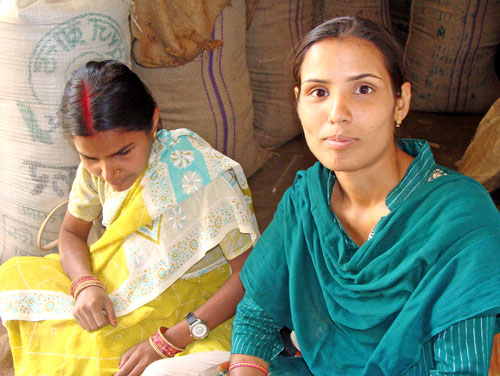
India has a “hidden face”… it is her disabled population, and they are all but denied and forgotten. Indeed, the statistics are staggering: there are over 70 million disabled persons in India; less than 5% of the disabled are educated; less than 30% are employed; more than 80% live in rural areas.
As it seems willing to do in rural situations of need and inequity, Chetna Vikas is wading in where others fear to tread…
Through its Community-Based Rehabilitation (CBR) program, Chetna Vikas improves the opportunities and quality of life of 254 disabled persons in 49 rural villages throughout Deoghar District. CBR is an approach to community development whereby Persons With Disabilities (PWDs) are enabled to live a fulfilling life within their own community. In turn, the community itself is educated to its own role and responsibilities in ensuring persons with disabilities are included and have opportunities to participate. Taken together, this dual strategy empowers the disabled to understand their rights, to exercise them, and to play a proactive role in community life.
Given the shocking statistics, and given the ambitious CBR program at Chetna Vikas, I had been anticipating this particular field visit for several weeks. The opportunity at hand for me today was a first-hand experience of PWD casework in the remote, rural villages of Naiyadih, Gadijamuwa, Sarasani and Gurigang, and to do so as the “shadow” of Sangita Kumari, a 25 year- old Chetna Vikas CBR Field Worker who has been dedicated to her work with India’s rural disabled since 2003. As it happened, today would open my eyes wide to what it truly takes to be Sangita…
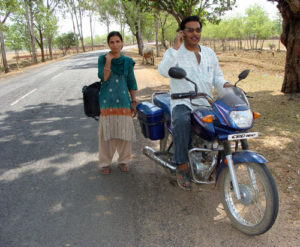 With Manoranjan (Chetna Vikas’ CBR Program Coordinator) at the handlebars, Sangita and I hopped on the back of the two-wheeler that would be our transportation through the mounting heat and sunshine of Deoghar’s late morning. By the time we reached the nearby Naiyadih Village, I had learned that we were enroute to meet Sunita, a 21 year old, blind woman with whom Sangita has been working for 5 years. Sangita spends about 2 hours with Sunita twice a week, as part of the CBR Individual Home Program (IHP). Through the IHP, Chetna Vikas provides Field Workers to work on a regular, one-to-one basis with persons with disabilities, helping them to slowly develop a program of “daily living activities” that is appropriate and relevant to their situation.
With Manoranjan (Chetna Vikas’ CBR Program Coordinator) at the handlebars, Sangita and I hopped on the back of the two-wheeler that would be our transportation through the mounting heat and sunshine of Deoghar’s late morning. By the time we reached the nearby Naiyadih Village, I had learned that we were enroute to meet Sunita, a 21 year old, blind woman with whom Sangita has been working for 5 years. Sangita spends about 2 hours with Sunita twice a week, as part of the CBR Individual Home Program (IHP). Through the IHP, Chetna Vikas provides Field Workers to work on a regular, one-to-one basis with persons with disabilities, helping them to slowly develop a program of “daily living activities” that is appropriate and relevant to their situation.
When we arrived at Sunita’s home in Naiyadih, Sunita was just finishing her morning bathing and dressing routines, so I was graciously ushered into a small seating area by Raj Kumar Pandit, Sunita’s father. Her father was happy to take the opportunity to pull out the stacks of files, folders, papers and photos that he has collected throughout the course of Sunita’s life and especially her association with Chetna Vikas. Raj Kumar’s obvious pride in his daughter was endearing, and he leafed proudly through a variety of documents including Sunita’s “Disability Certificate”, her marriage certificate, and notifications of her studies in areas such as chair weaving and candle-making.
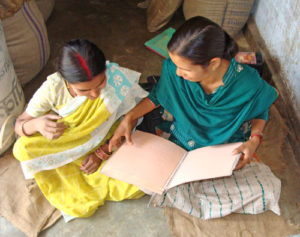 When Sunita finally joined us, I sat with her, her father, Sangita and Manoranjan, to learn a bit about the relationship and work between Chetna Vikas and this particular CBR beneficiary family. I learned that before Chetna Vikas intervention with Sunita began in 2003, she was a despondent young woman who rarely left home. When Sangita began to work with her, she focused on inspiring and encouraging Sunita, giving her mobility, both within her own homestead, and into the village. For instance, Sangita helped her to feel confident to use sounds and senses to cook and move about independently in the kitchen. Over time, Sunita’s attitude slowly changed, and she asked for the opportunity to undertake studies, to read braille, and to learn crafts.
When Sunita finally joined us, I sat with her, her father, Sangita and Manoranjan, to learn a bit about the relationship and work between Chetna Vikas and this particular CBR beneficiary family. I learned that before Chetna Vikas intervention with Sunita began in 2003, she was a despondent young woman who rarely left home. When Sangita began to work with her, she focused on inspiring and encouraging Sunita, giving her mobility, both within her own homestead, and into the village. For instance, Sangita helped her to feel confident to use sounds and senses to cook and move about independently in the kitchen. Over time, Sunita’s attitude slowly changed, and she asked for the opportunity to undertake studies, to read braille, and to learn crafts.
At this point in our informal meeting, Sunita left our small group, eager to make her guests some chai (and to show her capability to do so). Charmed as I was by Sunita and her family (who seemed to be gathering in increasing numbers around us), I continued to ask about Sunita’s evolution under Sangita’s care. I learned that since her involvement with Chetna Vikas CBR, Sunita has successfully attended school for the blind in Jasidih (classes 1-5) and Dehradul (classes 6-10), and she recently went to Deoghar to take the “Metric Exam” (i.e. the 10th class board exam after which Indian students choose a specialty). In fact, Sunita already aspires to ultimately have a government job as a teacher in a school for blind children!
 Eventually, as we finished our tea, it was time to bid Sunita and her family farewell and make our way out of Naiyadih. Before we left however, Sunita’s father made sure to tell us proudly about the small business loan he is seeking for his daughter so that she can earn income with her crafting skills. Sunita herself took the opportunity to show her new-found ability to thread through the eye of a needle, a skill she has learned through her recent training in mattress-stitching. As I touched Sunita’s hand and said goodbye, it struck me how important it is for persons with disabilities to have a loving, supportive familial environment that would encourage their participation in the CBR program and in life itself. Indeed, this appears to have played a crucial role in the way Sunita seems to continually unfold and expand her potential.
Eventually, as we finished our tea, it was time to bid Sunita and her family farewell and make our way out of Naiyadih. Before we left however, Sunita’s father made sure to tell us proudly about the small business loan he is seeking for his daughter so that she can earn income with her crafting skills. Sunita herself took the opportunity to show her new-found ability to thread through the eye of a needle, a skill she has learned through her recent training in mattress-stitching. As I touched Sunita’s hand and said goodbye, it struck me how important it is for persons with disabilities to have a loving, supportive familial environment that would encourage their participation in the CBR program and in life itself. Indeed, this appears to have played a crucial role in the way Sunita seems to continually unfold and expand her potential.
At our next field stop, Gadijamuwa Village, we were set to meet Jageshwar, a 6 year old boy with Cerebral Palsy (i.e. a disorder of posture, muscle tone and movement resulting from brain damage most commonly during pregnancy or childbirth). The plan was to meet up with Jageshwar and his young mother, Sonia Devi, on the grounds of a village Middle School. Having arrived before them, we sat in the shade of a large tree on the school grounds, watching village children – at first they were engrossed in play at the local water tap, but slowly, they gathered around us to investigate our curious presence. After a short time, I spotted Sonia, who appeared suddenly on the featureless, expansive horizon. She walked slowly under the hot mid-day sun, with a small child on her hip; she walked like a person who has been walking for a long time.
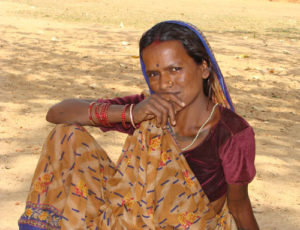 When they finally joined us in the shade of the tree, we shared introductions and settled ourselves in a circle. During a brief discussion with Sonia, I learned that Jageshwar has been in Chetna Vikas’ CBR program since 2003. Before that time, he performed almost no movement at all and simply laid still on a bed for the better part of each day. Anything else, such as feeding and bathing, were things that Sonia would do for him.
When they finally joined us in the shade of the tree, we shared introductions and settled ourselves in a circle. During a brief discussion with Sonia, I learned that Jageshwar has been in Chetna Vikas’ CBR program since 2003. Before that time, he performed almost no movement at all and simply laid still on a bed for the better part of each day. Anything else, such as feeding and bathing, were things that Sonia would do for him.
Sangita explained to me that her work in a case such as this begins with a focus on strengthening the overall muscles of the body to encourage movement and strength. Then, she adds activities to improve concentration, focus and coordination. Eventually, when he’s older and before his spine becomes fused by his condition, a special chair will be built for Jageshwar that will help to keep his limbs from twisting and will encourage his continued progress toward reading, writing and drawing.
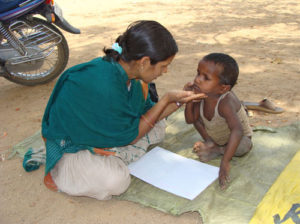 Having provided this much background information, Sangita then took the opportunity to begin a short session with Jageshwar. For about 30 minutes, she showed me how she works to encourage his limbs and movements, positioning and supporting his small body, speaking to him consistently to keep his attention, and even using pen and pencil to guide his hand with scribbles and doodles. At this young age, and given Jageshwar’s silent and uncommunicative state, Sangita works patiently and slowly to simply encourage the young boy’s interest and acceptance of the rehabilitative session. Jageshwar’s interest in the sessions is crucial — after all, it will be the focus and motivation that Jageshwar himself can one day achieve that will determine his overall progress in the program.
Having provided this much background information, Sangita then took the opportunity to begin a short session with Jageshwar. For about 30 minutes, she showed me how she works to encourage his limbs and movements, positioning and supporting his small body, speaking to him consistently to keep his attention, and even using pen and pencil to guide his hand with scribbles and doodles. At this young age, and given Jageshwar’s silent and uncommunicative state, Sangita works patiently and slowly to simply encourage the young boy’s interest and acceptance of the rehabilitative session. Jageshwar’s interest in the sessions is crucial — after all, it will be the focus and motivation that Jageshwar himself can one day achieve that will determine his overall progress in the program.
Despite Jageshwar’s lack of emotional affect and uncommunicative expressions, he has actually made important progress. These days, he can sit upright without support and he can even feed himself. I saw with my own eyes that his hands may not have been strong enough yet to hold and use the pencil that he was offered, but he was definitely interested in the activity. And importantly, Jageshwar’s mother, Sonia, also showed a very positive development… hope. At one point, she said that a few years ago, her son did nothing but sleep, today however, she hopes that he might eventually be able to work and even to walk.
As our motorbike took the three of us out of the Gadijamuwa school grounds, I looked over my shoulder at the spot under the tree where Jageshwar, his mother and the local children were still gathered. I felt a growing understanding that today’s field visits were showing me as much about a situation in rural India as they were about the spirit and fortitude of the CBR Field Worker. Indeed, I had already experienced several moments of profound respect for Sangita’s ability to extend physical and emotional care to Sunita and Jageshwar. I had always had a sense of her as a dedicated Chetna Vikas staff member, but until today I didn’t have a clue about the reality of the casework to which she dedicated heart and soul each day.
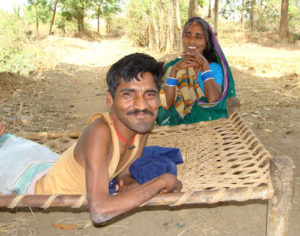 After just a short ride in the ever-increasing heat of the afternoon, we arrived at Sarasani Village to visit Dasrat, a 27 year old man with Cerebral Palsy. Dasrat’s physical posture, laid as he was in a twisted position on his belly on a make-shift outdoor cot, belied the bright eyes and smile which greeted us warmly. On his outdoor cot, in the shade of a tree behind the family home, Dasrat was surrounded by family, neighbors, all of whom greeted Sangita warmly as we approached. It was apparent that she had established excellent rapport with the community during her years of work with Dasrat.
After just a short ride in the ever-increasing heat of the afternoon, we arrived at Sarasani Village to visit Dasrat, a 27 year old man with Cerebral Palsy. Dasrat’s physical posture, laid as he was in a twisted position on his belly on a make-shift outdoor cot, belied the bright eyes and smile which greeted us warmly. On his outdoor cot, in the shade of a tree behind the family home, Dasrat was surrounded by family, neighbors, all of whom greeted Sangita warmly as we approached. It was apparent that she had established excellent rapport with the community during her years of work with Dasrat.
Almost immediately, Dasrat requested paper and pen, and worked entirely independently to get them into position in his hands and under his chin, so that he might begin a short demonstration of his skills in writing and math. Sangita took the opportunity to tell me that when she began working with Dasrat years ago, his mother was exhausted by the consistent and total care that she was forced to provide for her adult son — she fed, bathed, dressed and cared for him entirely. As with Jageshwar, Chetna Vikas CBR intervention with Dasrat began with the focus on physical and muscular strength and flexibility.
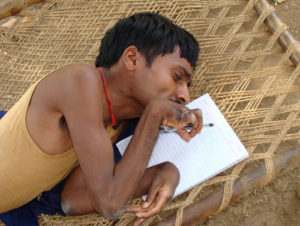 Given that he was already an adult, they began educational activities as well, and he was now confident and capable of basic literacy and math skills. Indeed, I watched as Dasrat worked with determination and will to position the pencil in his hand, then support his hand with his chin, and slowly write out his name, and various mathematical calculations on a sheet of paper.
Given that he was already an adult, they began educational activities as well, and he was now confident and capable of basic literacy and math skills. Indeed, I watched as Dasrat worked with determination and will to position the pencil in his hand, then support his hand with his chin, and slowly write out his name, and various mathematical calculations on a sheet of paper.
Dasrat continued to impress me. He explained happily that he has recently opened a bank account, so that he can benefit from the government’s “Disability Act” (i.e. “The Persons with Disabilities (Equal Opportunities, Protection of Rights and Full Participation) Act, 1995” was passed by the Indian Parliament in December of 1995). Under this law, he is eligible to receive a regular stipend if he has a registered Disability Certificate and a bank account. In his thoughtful manner, Dasrat told us that he intends to use any money that might accumulate in this account to pay for the services of those whom he needs to cook for him later in life.
Eventually, as we said our goodbyes, and walked back to the motorcycle, I reflected quietly on my meeting with Dasrat, and about that intangible personal quality of enthusiasm and determination that he radiated. He seemed to me to be a perfect example of the spirit which Chetna Vikas CBR attempts to cultivate in the disabled themselves through their casework in the field. It is a sense of purpose, ability, confidence and independence. And, in fact, this is what makes CBR intervention with the disabled work — “the disabled” are not approached as a group, each case is approached as unique, and care is taken to discover and to cultivate that which will inspire, encourage and motivate the individual him / herself to strive for and believe in his / her own development.
 And so, with the long day done, the three of us boarded the bike one more time and began the long journey back to Deoghar town. This time, Manoranjan, Sangita and I rode together on the motorbike in silence, watching the countryside slide by and reflecting on the day. I found myself reflecting on the Chetna Vikas Field Worker in disability, rather than the CBR program itself. While I had been moved by Sunita, Jageshwar and Dasrat, and I had been impressed by the nature of the CBR intervention activities in each case, it was Sangita herself on whom my thoughts focused. Before today, I had assumed a certain understanding of the work that she performed each day, but I had not fully grasped the emotional commitment that she must have made to this work a long time ago. Nor had I fully appreciated the graceful care that she was able to extend to each of her cases.
And so, with the long day done, the three of us boarded the bike one more time and began the long journey back to Deoghar town. This time, Manoranjan, Sangita and I rode together on the motorbike in silence, watching the countryside slide by and reflecting on the day. I found myself reflecting on the Chetna Vikas Field Worker in disability, rather than the CBR program itself. While I had been moved by Sunita, Jageshwar and Dasrat, and I had been impressed by the nature of the CBR intervention activities in each case, it was Sangita herself on whom my thoughts focused. Before today, I had assumed a certain understanding of the work that she performed each day, but I had not fully grasped the emotional commitment that she must have made to this work a long time ago. Nor had I fully appreciated the graceful care that she was able to extend to each of her cases.
Overall, today had shown me a mere fragment of the total Chetna Vikas CBR program – I hadn’t had time today to witness the CBR objectives to establish and facilitate “self- help groups” amongst the disabled and their families, to create awareness of the disabled at the policy level, or to link the disabled to services in their communities. Still, I can say with certainty that there is incredibly important work being done to alleviate an unimaginable situation of inequality and injustice. The abandonment and denial of such a significant population in rural India must begin through the hearts and hands of people like Sangita — those who simply believe that all people are equal, beautiful, and deserving of the effort required to help them believe in themselves first.
~~~~~~~~~~~~~~~~~~
[This is an excerpt from a journal I kept while working in India years ago with a small organization called “Chetna Vikas”. I lived and worked in a very remote, rural town called Deoghar, near the border of Bangladesh. This specific journal entry was written on March 29, 2008.]